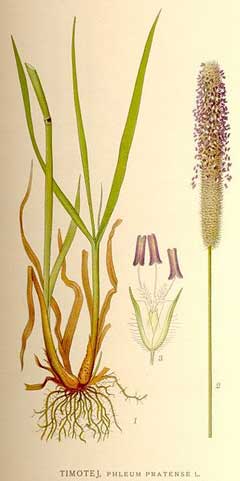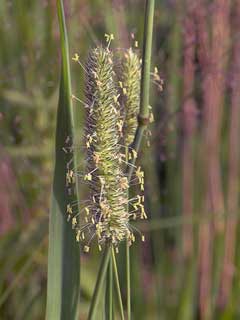 |
|
http://commons.wikimedia.org/wiki/File:Timotej.jpg |
 |
| http://commons.wikimedia.org/wiki/User:RasbakPhlomis fruticosa |
Translate this page:
Summary
Physical Characteristics

 Phleum pratense is a PERENNIAL growing to 1 m (3ft 3in).
Phleum pratense is a PERENNIAL growing to 1 m (3ft 3in).
See above for USDA hardiness. It is hardy to UK zone 5. It is in flower in July. The species is hermaphrodite (has both male and female organs) and is pollinated by Wind.
Suitable for: light (sandy), medium (loamy) and heavy (clay) soils. Suitable pH: mildly acid, neutral and basic (mildly alkaline) soils. It can grow in semi-shade (light woodland) or no shade. It prefers moist soil.
UK Hardiness Map
US Hardiness Map
Synonyms
Plant Habitats
Meadow;
Edible Uses
References More on Edible Uses
Medicinal Uses
Plants For A Future can not take any responsibility for any adverse effects from the use of plants. Always seek advice from a professional before using a plant medicinally.
Cancer
Stored sterile timothy extracts arrested the growth of Sarcoma 45 and other tumour types[269].
References More on Medicinal Uses
The Bookshop: Edible Plant Books
Our Latest books on Perennial Plants For Food Forests and Permaculture Gardens in paperback or digital formats.

Edible Tropical Plants
Food Forest Plants for Hotter Conditions: 250+ Plants For Tropical Food Forests & Permaculture Gardens.
More

Edible Temperate Plants
Plants for Your Food Forest: 500 Plants for Temperate Food Forests & Permaculture Gardens.
More

More Books
PFAF have eight books available in paperback and digital formats. Browse the shop for more information.
Shop Now
Other Uses
Biomass Fodder Hair
The stems have been used to make hair brushes[257]. The plant can yield up to 15 tonnes of plant material per hectare and is a potential source of biomass[269].
Special Uses
Carbon Farming Food Forest
References More on Other Uses
Cultivation details
Fodder: Pasture Management: Hay Management: Standard Staple Crop: Balanced carb
An easily grown plant, it succeeds in a sunny position in any ordinary soil[200]. The plant is not drought tolerant[269]. Timothy grass is reported to tolerate an annual precipitation in the range of 35 to 176cm, an annual temperature range of 4.4 to 18.6°C, and a pH of 4.5 to 7.8[269]. The plant is best adapted to a cool, humid, temperate climate, growing best on rather heavy, deep and moist or even wet soils[269]. Yields are lower on light dry soils and sands[269]. The optimum temperature for growth is 18.3° - 21.6°C varying with day/night temperatures of 15°/10°C and 21°/15°C[269]. Timothy grass is a very variable species that is commonly grown as a hay grass. Several named forms have been develped[17, 269]. A short-lived perennial it is a common cause of hayfever[257]. An attractive addition to the wild flower meadow, the inflorescence dries and dyes well so is used in dried flower displays[200].
Carbon Farming
-
Fodder: Pasture
Enclosed tracts of farmland mainly of grasses, with an interspersion of legumes and other forbs (non-grass herbaceous plants).
-
Management: Hay
Cut to the ground and harvested annually. Non-destructive management systems maintaining the soil organic carbon.
-
Management: Standard
Plants grow to their standard height. Harvest fruit, seeds, or other products. Non-Destructive management systems.
-
Staple Crop: Balanced carb
(0-15 percent protein, 0-15 percent oil, with at least one over 5 percent). The carbohydrates are from either starch or sugar. Annuals include maize, wheat, rice, and potato. Perennials include chestnuts, carob, perennial fruits, nuts, cereals, pseudocereals, woody pods, and acorns.
References Carbon Farming Information and Carbon Sequestration Information
Temperature Converter
Type a value in the Celsius field to convert the value to Fahrenheit:
Fahrenheit:
The PFAF Bookshop
Plants For A Future have a number of books available in paperback and digital form. Book titles include Edible Plants, Edible Perennials, Edible Trees,Edible Shrubs, Woodland Gardening, and Temperate Food Forest Plants. Our new book is Food Forest Plants For Hotter Conditions (Tropical and Sub-Tropical).
Shop Now
Plant Propagation
Seed - sow spring in situ, only just covering the seed. If seed is in short supply, it can be surface sown in a pot in a cold frame. Ensure the pot does not dry out. When large enough to handle, prick the seedlings out into individual pots and plant out in the summer. Division in spring.
Other Names
If available other names are mentioned here
Native Range
TEMPERATE ASIA: Iran, Iraq, Turkey, Russian Federation-Ciscaucasia (Ciscaucasia), Armenia, Azerbaijan, Georgia, Russian Federation (Dagestan), Russian Federation (Altay, Buryatia, Chita, Gorno-Altay, Irkutsk (south), Kemerovskaja oblast, Krasnoyarsk (south), Kurganskaja oblast, Novosibirsk, Omsk, Tomsk, Tyumen (south), Tyva, Respublika, Yakutia-Sakha (south)), Kazakhstan (southeast), Kyrgyzstan, Mongolia, China (north) TROPICAL ASIA: India (north), Pakistan (north) EUROPE: Denmark, Finland, United Kingdom, Norway, Sweden, Austria, Belgium, Switzerland, Czech Republic, Germany, Hungary, Poland, Slovakia, Russian Federation (European part), Belarus, Estonia, Lithuania, Latvia, Moldova, Russian Federation (Saratov, Volgogradskaja oblast), Ukraine (incl. Krym), Albania, Bulgaria, Greece, Croatia, Italy (incl. Sardinia, Sicily), Romania, Serbia, Slovenia, Spain, France (incl. Corsica), Portugal AFRICA: Algeria (north), Egypt, Morocco, Tunisia
Weed Potential
Right plant wrong place. We are currently updating this section.
Please note that a plant may be invasive in one area but may not in your area so it's worth checking.
Conservation Status
IUCN Red List of Threatened Plants Status :

Growth: S = slow M = medium F = fast. Soil: L = light (sandy) M = medium H = heavy (clay). pH: A = acid N = neutral B = basic (alkaline). Shade: F = full shade S = semi-shade N = no shade. Moisture: D = dry M = Moist We = wet Wa = water.
Now available:
Food Forest Plants for Mediterranean Conditions
350+ Perennial Plants For Mediterranean and Drier Food Forests and Permaculture Gardens.
[Paperback and eBook]
This is the third in Plants For A Future's series of plant guides for food forests tailored to
specific climate zones. Following volumes on temperate and tropical ecosystems, this book focuses
on species suited to Mediterranean conditions—regions with hot, dry summers and cool, wet winters,
often facing the added challenge of climate change.
Read More
Expert comment
Author
L.
Botanical References
17200
Links / References
For a list of references used on this page please go here
Readers comment
| Add a comment |
|
If you have important information about this plant that may help other users please add a comment or link below. Only comments or links that are felt to be directly relevant to a plant will be included. If you think a comment/link or information contained on this page is inaccurate or misleading we would welcome your feedback at [email protected]. If you have questions about a plant please use the Forum on this website as we do not have the resources to answer questions ourselves.
* Please note: the comments by website users are not necessarily those held by PFAF and may give misleading or inaccurate information.
To leave a comment please Register or login here All comments need to be approved so will not appear immediately.
|
Subject : Phleum pratense
|
|
|
|